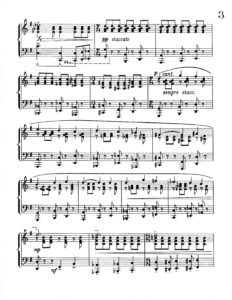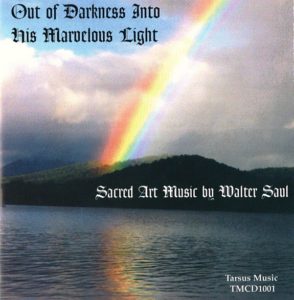Coming just off of Mother’s Day, I thought it would be good to talk about parenthood a little. My wife and I are blessed with two daughters who always remember Mother’s Day and Father’s Day in special and different ways. And, of course, they came into the world in very different and unforgettable ways which always bring a smile to my heart when I remember those lifegiving and breathtaking moments (and, yes, the long hours and days before those moments)!
I wish that, in 1984, I could report to you that all that was on my mind was the birth of my younger daughter, who arrived in September. But there was a death on my mind as well – the death of my compositional career. Grimly, I determined to write one more piano sonata and then do something else with my life. It would be highly modernistic and pessimistic, like the first movement of the second piano sonata, and then that would be it.
 Evidently, Someone Else had a hand in getting Sonata No. 3 written, for what emerged from my pencil chicken scratches on the staff lines was joyous and lifegiving, a much happier response to our now-complete family. The three movements were sketched very quickly, over the course of three weeks as I recall. Before long all 29 pages of the sonata were calligraphed and ready for reproduction. It’s hard to believe that I once spent four or five hours with pen and ink making the music look printed – five years before Finale came out! Here’s a sample of the score.
Evidently, Someone Else had a hand in getting Sonata No. 3 written, for what emerged from my pencil chicken scratches on the staff lines was joyous and lifegiving, a much happier response to our now-complete family. The three movements were sketched very quickly, over the course of three weeks as I recall. Before long all 29 pages of the sonata were calligraphed and ready for reproduction. It’s hard to believe that I once spent four or five hours with pen and ink making the music look printed – five years before Finale came out! Here’s a sample of the score.
So Sonata No. 3, far from being the epitaph to my career, actually became the resurrection for it. The three movements formally are rather conventional. I love the sonata-allegro form and have employed it countless times, so it’s no surprise that the opening movement is in that form. The second movement is an Adagio in song form, and the finale is in second rondo form (ABABA), much the way that Franz Schubert and Frederic Chopin employed it with the first episode returning rather than a third theme.
As for the rhythms, themes and the harmonies – well, that’s your call. The first movement, Allegro con fuoco, is indeed fiery, energetic music invoking complex time signatures such as 7/8 and 8/8, raucous jazz harmonies (much of this movement seems to sit on a minor 11th chord). It starts off in E minor and moves the long way to its relative major, G Major, but via its Neapolitan 6th chord, Ab major, an unconventional approach to the most conventional place for the second theme. True to form, the exposition is repeated – truly old-fashioned! However, someone once taught me that the development section, which goes through many partial statements of these two themes, should go through many keys. I will not disappoint my listeners here; there are at least nine different keys, most of which are not closely related to the long-abandoned tonality of E minor. They include F# Major, D# minor, F# minor, D Major, F Major, C# Major, and then a retransition to the recapitulation that loses the key altogether before disintegrating into a three-chord pattern that is in the twelve-tone serial technique. The two themes return with a mighty explosion of joy, but the second returns now in the parallel major of E Major, just as Ludwig van Beethoven and many Romantic composers did. The final triumphant chords recall the twelve-tone pattern of the three chords leading into the recapitulation.
The middle movement is probably my best channeling of Chopin, a true nocturne, in C Major, that invokes the repeated tones of Chopin’s Raindrop prelude in D-flat Major and the descending chromatic harmonies of his famous prelude in E minor. In the contrasting theme the left hand arpeggiates mostly triads spread out in Chopin’s signature wide spacing, while setting up a 3/8 left hand pattern that goes against the common time of the right hand’s cantabile melodies. Again, many gentle jazz-influenced harmonies evocative of George Gershwin grace this nocturne, the only movement with any trace of melancholy, especially at the end, where C Major was firmly established, only to melt into C minor in the final arpeggiations at the extreme ends of the keyboard.
If the first two movements evoke the worlds of jazz and Romanticism, the finale is a romp that invokes the worlds of the polka and straight-out rock ‘n’ roll. Contrary to the expectation of returning to E minor, this movement takes the hint from that closing C minor chord above and begins in the closely related key of A-flat Major. Bright, simple repeated triads draw the curtain aside for a cheerful melody with absolutely no accidentals – could this really be the music of Saul? The eighth measure comes to the rescue with a sudden jag to G-flat Major, but is quickly herded back to A-flat as the left hand melody and right hand chords swap hands. The flats that don’t belong, however, sneak back in and catapult the piece into a very strange section of the first theme that starts the rock riff with now-repeated eighth notes leading back to A-flat for the third, truly rock ‘n’ roll version of the rondo theme. Another bizarre modulation careens us into the key of E minor (the key from the opening movement and a chromatic mediant relationship to A-flat, one of my favorite harmonic relationships). Alas, this “return” to E minor is for the second theme and, like Igor Stravinsky, too many “wrong notes” lead this theme into some tonal confusion, but it bumps back into the home key of A-flat for the second refrain of the rondo theme. After a rude interruption by cascading, seemingly random chords, the familiar tune now makes its way into the left hand, but pops around in several high and low registers. Like the first refrain, this one also has a strange middle section that frolicks through too many keys and even brushes up against some atonality before coming back with the rock ‘n’ roll version of the tune. Now, however, it bolts to B Major, and D Major, too, on the way to…F minor. Yes, the long way around again, just to get to the relative minor, which brings back the short second theme. And, as before, the tonality again starts to deteriorate, so badly that the last refrain enters in the wrong key of A Major (yes, this is an old Beethoven trick).  Fortunately, a couple of weird chords and some naughty parallel fifths come to the rescue and rope it back into the correct key of A-flat, but it escapes again into E Major with some 9th, 11th, and 13th chords that bring us to the last rock ‘n’ roll proclamation of triumph as A-flat survives to the end.
Fortunately, a couple of weird chords and some naughty parallel fifths come to the rescue and rope it back into the correct key of A-flat, but it escapes again into E Major with some 9th, 11th, and 13th chords that bring us to the last rock ‘n’ roll proclamation of triumph as A-flat survives to the end.
It’s interesting to note that E, C, and A-flat, the tonalities of the three movements, form an augmented triad which sectors an octave into three equal parts, each part being a major third. This reference to the Holy Trinity is intentional and recalls the augmented triads that frequently structure Franz Liszt’s tonal patterns. An excellent example of that is his ubiquitous Liebesträume Nocturne No. 3, which starts out in A-flat Major and has two climatic passages in C Major and E Major on the return to A-flat. In my Sonatina No. 5, composed 31 years later for my good friend and pianist Walter Cosand, I use the same augmented triad structure for the movement keys of B Major, E-flat (but serialist in nature), and G Major.
Please enjoy Sonata No. 3 for Piano as recorded on my first CD, Out of Darkness Into His Marvelous Light, at Sonata #3 For Piano – Allegro Con Fuoco in Sonata #3 for Piano (soundcloud.com). If you enjoy what you hear, consider investing in the entire CD and others at http://waltersaul.com/ and click on the link at the top of the page.